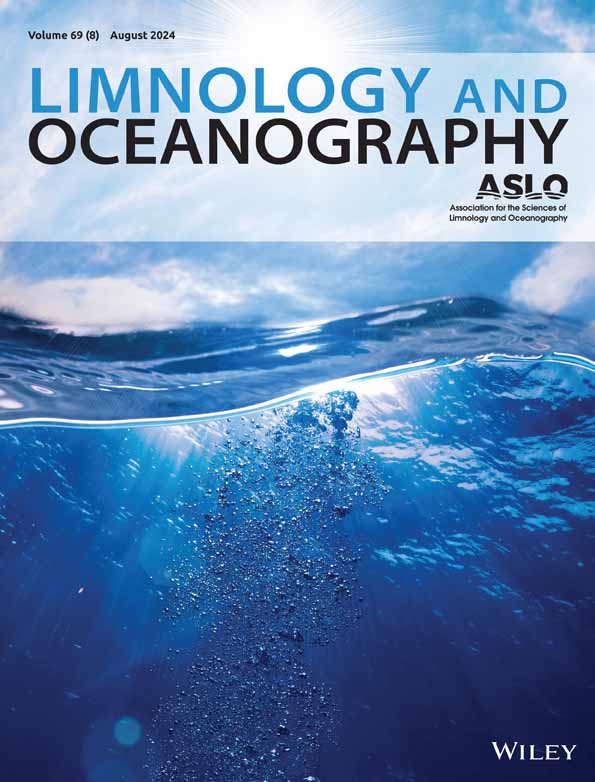翼足类动物作为海洋酸化的预警指标
IF 3.8
1区 地球科学
Q1 LIMNOLOGY
引用次数: 0
摘要
预计到2050年,南极威德尔海文石欠饱和(1)事件的频率和持续时间将迅速增加。由于翼足类动物的文石壳在低饱和状态下容易溶解,因此它们是海洋酸化的生物指示物。在这里,我们描述了2018年南方夏季与威德尔海南部水柱相关的翼足类南极Limacina helicina antarctica的壳溶解状态,作为未来监测正在进行的OA的基准。采样点的深度剖面始终接近或处于翼足类壳溶解阈值(1.1 ~ 1.3)范围内。翼足类占中浮游动物总生物量的69%,其分布与叶绿素a浓度呈正相关。扫描电镜分析显示,78%的甲壳存在溶蚀现象,其中50-69%的甲壳存在更为严重的II型溶蚀,超过了目前南大洋翼足类甲壳溶蚀的预测。但重要的是,在我们的研究中,只有两个标本具有最严重的III型溶解。溶解通常与起源不明的划痕同时发生,这支持了完整的骨膜保护外壳不被溶解的观点。如果溶解发生在没有划痕或没有骨膜破裂证据的情况下,那么微尺度/纳米尺度的破裂可能是溶解开始的重要途径,这支持了最近发现的低/低ph导致有机壳含量减少的结果。我们在这里提供的溶解基准允许翼足类动物作为威德尔海OA可能进展的早期预警指标的应用。本文章由计算机程序翻译,如有差异,请以英文原文为准。
Pteropods as early‐warning indicators of ocean acidification
Aragonite undersaturation ( 1) events are projected to rapidly increase in frequency and duration in the Antarctic Weddell Sea by 2050. Thecosome pteropods (pelagic snails) are bioindicators of ocean acidification (OA) because their aragonite shell dissolves easily at low saturation states. Here, we describe the shell dissolution state of the pteropod Limacina helicina antarctica in relation to the water column in the southern Weddell Sea during austral summer 2018 as benchmark for future monitoring of ongoing OA. depth profiles at the sampling sites were consistently close to or in the range of threshold levels ( 1.1–1.3) for pteropod shell dissolution. Pteropods contributed up to 69% of total mesozooplankton biomass, and their distribution correlated positively with and chlorophyll a concentration. When analyzed with scanning electron microscopy, 78% of the investigated shells exhibited dissolution, and 50–69% showed the more severe Type II dissolution exceeding current projections of pteropod shell dissolution for the Southern Ocean. But importantly, in our study, only two specimens had the most severe Type III dissolution. Dissolution often co‐occurred with and occurred in scratch marks of unclear origin supporting notions that an intact periostracum protects the shell from dissolution. Where dissolution occurred in the absence of scratches or absence of evidence of periostracum breaches, microscale/nanoscale breaches may have been an important pathway for dissolution commencement supporting recent findings of a reduction of the organic shell content caused by low /low pH. The dissolution benchmark we provide here allows future application of pteropods as early‐warning indicators of presumably progressing OA in the Weddell Sea.
求助全文
通过发布文献求助,成功后即可免费获取论文全文。
去求助
来源期刊

Limnology and Oceanography
地学-海洋学
CiteScore
8.80
自引率
6.70%
发文量
254
审稿时长
3 months
期刊介绍:
Limnology and Oceanography (L&O; print ISSN 0024-3590, online ISSN 1939-5590) publishes original articles, including scholarly reviews, about all aspects of limnology and oceanography. The journal''s unifying theme is the understanding of aquatic systems. Submissions are judged on the originality of their data, interpretations, and ideas, and on the degree to which they can be generalized beyond the particular aquatic system examined. Laboratory and modeling studies must demonstrate relevance to field environments; typically this means that they are bolstered by substantial "real-world" data. Few purely theoretical or purely empirical papers are accepted for review.
 求助内容:
求助内容: 应助结果提醒方式:
应助结果提醒方式:


